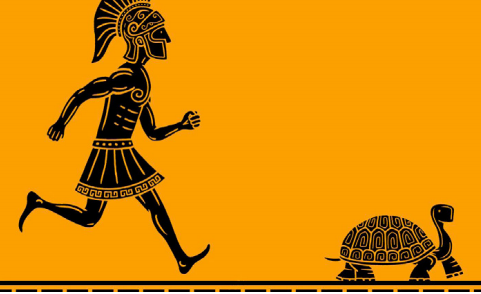【诺奖得主Wilczek科普专栏】芝诺悖论遐想
以下文章来源于蔻享学术 ,作者KouShare
传播科学、共享科学、服务科学

来源:蔻享学术
作者 | Frank Wilczek
翻译 | 胡风、梁丁当

Frank Wilczek
弗兰克·维尔切克是麻省理工学院物理学教授、量子色动力学的奠基人之一。因发现了量子色动力学的渐近自由现象,他在2004年获得了诺贝尔物理学奖。


古希腊哲学家芝诺曾提出 3 个著名悖论,直到一千多年后,这些数学、物理领域的难题才被解开。
面对同一个问题,我们用不同的方式进行思考,却得到了矛盾的结论,于是悖论就产生了。然而大自然是不可能自相矛盾的。所以,物理悖论的出现意味着我们的思考出现了错误,这也推动了我们不断进步。
在物理学史上,悖论扮演着光辉的角色。16岁的少年爱因斯坦想象着如果他可以追上光,那么他看到的现象会违背当时的物理学定律。经过10年的思考,他提出了狭义相对论,其中证明了光是不可能被追上的。
公元前5世纪,一位早于苏格拉底的哲学家——埃利亚的芝诺(Zeno of Elea)——提出了几个关于变化与运动本质的著名悖论。约2500年后,英国哲学家伯特兰 · 罗素(Bertrand Russell)写道 :“在某种形式上,芝诺的论辩奠定了从他那个时代至今的所有关于时间、空间与无限的理论基础。”
芝诺的悖论可以归结为3个方面 :无限悖论、零化度悖论和静止悖论。
芝诺讲的阿喀琉斯和乌龟赛跑的故事很好地演示了无限悖论。阿喀琉斯从A点开始跑,同时乌龟从A前面的B点出发。当阿喀琉斯跑到B的时候,乌龟已经到了C。阿喀琉斯追到C的时候,乌龟又往前跑了一小段距离。这样的连续剧情反复上演,每集的时长是有限的,而集数却是无穷的。那么阿喀琉斯是怎么在有限的时间内追上乌龟的?
零化度悖论讲的是 :线是由点组成的,而点的长度为零,无论多少个零加在一起,仍然是零。那么线是怎么获得非零长度的?
在这两个悖论中,“正确”的答案都是一个有限量,但根据芝诺的分析,前一个悖论中的时间是无穷的,后一个的线段长度为零。
对于芝诺悖论中的逻辑问题,正确的解答直到近代才最终出现。19世纪时,数学家学会了如何求解一个递减的无穷级数。数学理论表明,如果级数是收敛的,那么它就会趋向一个确定的有限值。
到了20世纪,数学家知道了如果将足够多的零累加,确实可以得到非零值。解决这个问题需要用到高等数学中的测度论(measure theory)。该理论出名地晦涩难懂,需要大量技巧才能掌握。
“芝诺之箭”讲述的是静止悖论。在每个时刻,箭都在一个固定的位置,而箭尖则是一个零长度的点。无论把多少个时刻加在一起,我们都得不到一个有限的距离,所以箭没有动。根据现代物理中的时空连续性,我们可以用与解决零化度悖论相同的数学技巧来解决静止悖论。
而如果时空是离散的,那么箭就能够在每个时刻从一个点跳到另一个点。这是对静止悖论的另一种解答。这个回答更加简单,更契合我们数字化时代的精髓。就像一部电影,说到底,是由一帧帧离散的镜头构成的。
牛顿说 :“如果以较少的付出就能达到结果,大自然绝不会做更多的无用功 ;自然界喜欢简单和高效,而不喜欢浮夸的排场。”可为什么它没有选择数字化,从而避免芝诺悖论中所有的微妙疑惑呢?你可以说这又是个悖论——芝诺悖论依然存在。

The ancient philosopher's famous riddles highlightedproblems in math and physics that would takemillennia to solve.
Paradoxes arise when different ways of thinking about a situation lead to contradictory conclusions. Since nature cannot contain contradictions, physical paradoxes point to flaws in our thinking. They invite us to do better.
Paradoxes have played a glorious role in the history of physics. Young Albert Einstein, at the age of 16, saw that if he could catch up to a light beam he would see things that contradicted the existing laws of physics. Ten years of thinking later, his special theory of relativity showed why it was impossible to catch up with a light beam.
The pre-Socratic philosopher Zeno of Elea, who lived in the 5th century B.C., produced several famous paradoxes concerned with the nature of changeand motion. Almost 2,500 years later, Bertrand Russell wrote that "Zeno's arguments, in some form, have afforded grounds for almost all theories of space and time and infinity which have been constructed from his time to our own."
Zeno's paradoxes can be boiled down to three: the paradox of infinity, the paradox of nullity and the paradox of stasis.
Zeno's story about a race between Achilles and a tortoise nicely illustrates the paradox of infinity. Achilles starts atpoint A while the tortoise starts ahead, at point B. By the time Achilles gets to B the tortoise has moved on to point C. Rinse, lather, repeat. Each episode takes a finite amount of time, and there are an infinite number of episodes. How does Achilles manage to catch up (in a finite time)?
The paradox of nullity goes as follows. Lines are made from points. But the length of a point is zero, and no matter how many zeros you add together, you still get zero. So how do lines achieve nonzero length?
In both paradoxes the "right" answer is a finite quantity, but Zeno's analyses suggest infinite time in one case and zero space in the other.
Logically satisfactory answers to those paradoxes only emerged relatively recently. In the 19th century, mathematicians learned how to deal with infinite sums of decreasing terms. The theory shows that when the sum "converges," there is a well-defined, finite answer.
In the 20th century they learned to accommodate the fact that by adding zero enough times you actually can get past zero. This kind of question is treated in an advancedchapter of mathematics called measure theory, which is notoriously tricky and unintuitive.
Zeno's arrow introduces the paradox of stasis. At every instant an arrow is at one place, and the tip of the arrow, a point, takes up zero distance. No matter how many instants we add, we never achieve a finite distance, so thearrow cannot move. In present-day physics, based on a space-time continuum, the arrow paradox is solved using the same tricky mathematics that resolves the paradox of nullity.
If space and time were both discrete, then the arrow could just hop, at each tick of time, from one position to another. That simpler alternative seems more in tune with our digital age. A movie, after all, is really a series of snapshots.
According to Isaac Newton, "Nature does nothing in vain when less will serve; for Nature is pleased with simplicity and affects not the pomp of superfluous causes." Why doesn't it go digital, thus avoiding Zeno's subtleties? You could say it’s a paradox. Zeno lives.

编辑:黄琦

编辑:夏至
